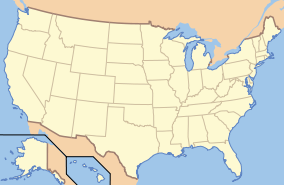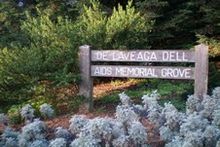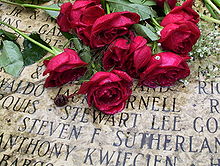- AIDS Memorial Grove
-
National AIDS Memorial Grove Location San Francisco, California, USA Coordinates 37°46′12″N 122°27′41″W / 37.77°N 122.46139°WCoordinates: 37°46′12″N 122°27′41″W / 37.77°N 122.46139°W Area 7.5 acres (1000 m²) Established Created September of 1991, Nationalized in November of 1996
The National AIDS Memorial Grove (The Grove) in Golden Gate Park, San Francisco, California, is a dedicated space in the national landscape where millions of Americans touched directly or indirectly by AIDS can gather to heal, hope, and remember. The mission of the Grove is to provide a healing sanctuary and to promote learning and understanding of the human tragedy of the AIDS pandemic.
Contents
History


The idea for the AIDS memorial was conceived in 1988 by a small group of San Francisco residents representing a community devastated by the AIDS epidemic, but with no positive way to express their collective grief. They envisioned a serene place where people would come alone or in groups to hold memorial services, to remember among the rhododendrons and redwoods. As news of the Grove initiative grew, so did support and interest.
The group selected as the site for the Grove the de Laveaga Dell in world-renowned Golden Gate Park. Due to park budget cuts and lack of funding, the Dell had fallen into a state of disrepair, overgrown and unusable by the public. A team of prominent architects, landscape architects, and designers volunteered countless hours to create a landscape plan that would be fitting as a timeless living memorial.
Site renovation began in September 1991, and is still in progress. The Grove is an award-winning example of civic beautification, combining both public and private sectors in urban-park restoration and promoting AIDS awareness. The Grove’s board of directors obtained a 99-year renewable lease with the City of San Francisco to create and maintain the Grove. Public officials praise the project as the perfect example of a public-private partnership. The Grove has become a model project for like-minded groups throughout the world.
In October 1996, a historic milestone was reached when Congress and the President of the United States approved legislation that included the designation of the site as the National AIDS Memorial, giving it a status comparable with the Vietnam Veterans Memorial, Mount Rushmore, and the USS Arizona at Pearl Harbor. Most memorials are built after the struggle is over. The Grove is becoming the national gathering place even as the 30-year AIDS pandemic continues to invade humanity in unprecedented numbers—and especially as the world commemorates World AIDS Day every December First.
Community Support
Community response is the heart of the Grove. During its first decade, the Grove was transformed into a lush and tranquil site visited by thousands of people annually. Since 1991, thousands of citizens have donated more than 100,000 hours participating in monthly Community Volunteer Workdays. Workday volunteers come from all segments of the community and represent a diverse range of racial, economic, cultural, school, religious, and service groups. Under professional supervision, they continue to restore the Grove by clearing overgrowth and reintroducing native species, planting thousands of new trees, plants, and shrubs.
The Grove exists in large measure because of the generous contributions from individuals, philanthropic organizations and corporations. As with most Grove donations to date, funds for the completion of the Grove’s endowment will be raised almost entirely from nongovernmental sources. The Grove’s mission is to promote learning and understanding of the human tragedy of the AIDS pandemic, both to current and future generations. Since its founding more than twenty years ago, the Grove by its very nature has served as a hands-on classroom for HIV/AIDS awareness and environmental education. Part of the Grove’s story incorporates how San Francisco responded to the AIDS crisis by creating what is now known worldwide as the “San Francisco Model.” This model was in part based on common sense, in part driven by desperation, but always fueled by creative individual activism.
By its very existence the Grove transforms stigma into dignity, grief into resolution and death into life. The Grove believes that bringing young and old together with diverse backgrounds, talents and experiences ultimately leads to diverse thinking, new approaches to life challenges and healthier community collaborations. The Grove will always remind future generations that through community activism and compassion one finds a potent antidote to misery and prejudice. The Grove’s youth programming provides important historical lessons which increase youth awareness of HIV/AIDS, while empowering them to take action to improve the communities in which they live.
History of the Grove
1988
- Isabel Wade and Nancy McNally envision “A beautiful grove where people could find solitude and hope while remembering loved ones… a place to provide a positive focus for our grief”. The idea was shared with mutual friends to create a living tribute to friends lost to AIDS.
1989
- A Steering Committee is formed to pursue the idea the Recreation and Parks Department in San Francisco.
- (Winter) Three donations in memory of prominent local landscape architect Stephen Marcus, provide initial funds for the Grove as a project of Friends of the Urban Forest.
1990
- (February) The Grove Steering Committee chooses the long-neglected de Laveaga Dell for the AIDS Memorial Grove. The Dell was created through a gift from the estate of Jose Vicente de Laveaga in 1898. When the Dell was opened to the public on June 21, 1921, it included a lake, meandering stream, irises, over-hanging oaks and spectacular ferns. John McLaren supervised the development that featured rare rhododendrons, lush camellias, and artfully constructed faux boulders. The Grove was well maintained during the first half of the century, later suffering from a lack of funds for maintenance. In the early days, the Dell was known as the Deer Glen and used by the zoo to house animals. In addition, there was a bear housed in the rise at the far western end, now known as the Fern Grotto.
- (November) The first fundraiser was held at the residence of steering committee member James C. Hormel.
1991
- (September) Ground Breaking with Mayor Art Agnos and 75 community volunteers at the first Volunteer Workday in the Grove. Twenty-two Bay Area Landscape Architects, Architects, Artists and Park personnel under the guidance of Garrett Eckbo developed a basic design for the AIDS Grove.
1992
- Design Plan approved by Park Commission. The steering committee agrees to work with volunteers to clean up and restore the dell, while at the same time, raising monies for an endowment to pay for a city gardener and maintaining the Grove in perpetuity. This agreement creates a model for public – private partnerships in public spaces.
1993
- (July) Kerry Enright hired as first Grove Executive Director. Initial funds provided by Columbia Foundation and James C. Hormel. AIDS Grove and City sign a ninety-nine year lease.
1994
- (December) First official observance of World AIDS Day in the Grove.
1995
- (February) Main Portal dedicated by benefactor Steve Silver, Creator and Producer of San Francisco’s Beach Blanket Babylon on his 51st (and last) birthday. In Steve’s words, “The Grove represents the spirit of the people who have left and the memories that will always be there.”
- (July) Joan Chase Velluntini, a 20 year park employee, becomes the first fulltime gardener funded by the Grove as part of agreement with San Francisco.
1996
- (February) Roll-out of Circle of Friends
- (April) NBC’s Today Show spotlights AIDS Memorial Grove in a segment by correspondent Dawn Frantangelo, filmed in January during initial engraving of her brother’s name in the Circle of Friends.
- The Dogwood Crescent, home to The Circle of Friends, is installed
- Woodland Path accessibility ramp installed.
- Meadow Overlook created through the first major capital campaign gift – funded by the Richard and Rhoda Goldman Fund
- Woodland Stream created over two workdays by bucket brigades of volunteers handing stones from delivery pallets to the streambed.
- (October) U.S. Congress designates The AIDS Memorial Grove as an official National Memorial. Legislation initiated by Representative Nancy Pelosi and Senator Dianne Feinstein.
- (December) World AIDS Day Dedication of the South Portal feature underwritten by Terry Watanabe of Omaha
1997
- Fern Grotto, Gathering Area feature installed.
1998
- (August) Garden Design Magazine publishes “A Healing Landscape” by Harriet Heyman with input from Grove founders and designers.
1998
- (December) At the fifth World AIDS Day, Irene Smith receives the first GROVE AWARD for her pioneering work in founding Service Through Touch.
- (December) First Lady Hillary Rodham Clinton visits The National AIDS Memorial Grove.
1999
- The National AIDS Memorial Grove receives Silver Rudy Bruner Award for Urban Excellence in the United States. The award “seeks to illuminate the complex process of urban place-making, so that it may be strengthened to better reflect the balance between form and use; opportunity and cost; preservation and change.”
- Tom Hanks (Oscar winner for his portrayal of a gay man suing his employer for AIDS based discrimination in “Philadelphia”) records Public Service Announcement for The National AIDS Memorial Grove.
- Moonwalk Way (funded by the Moonwalk Foundation honoring Vivien Schneider and Silva Watson) approved to control erosion.
- (December) World AIDS Day honors Celi Adams, RN, founder of Home Care Companions.
2000
- (March) Garden Design Magazine publishes “A Healing Garden” by Zazel Loven with emphasis on the healing function of the Memorial.
- (April) Woodland Stream extended to meadows edge
- (May) First annual fundraiser in the Grove “An Fair to Remember” gala and bazaar.
- (September) State of California appropriates $500,000 to the Grove (the only public monies in Grove history).
- (October) World Landmarks.com lists National AIDS Memorial Grove.
- (December) World AIDS Day observed with “All Our Communities Can Make a Difference” theme. Hosea Turner, Shanti’s Transportation Manager, receives Grove Award for community service.
2001
- (May) Second Annual Fundraiser: “Oasis – a Shopping Safari”.
- (June) Grove commemorates 20 years of AIDS.
- (December) Grove honors families at World AIDS Day Observance. Jim Greenshields, Coming Home Hospice Chef, receives Grove Award for Community Service.
2002
- Western Portal, gift of the Donald O Collins Foundation, installed
- (May) Third Annual Grove Fundraiser: “Shangri La, A Shoppers Paradise”.
- (May) Construction of Crossroads Circle (the final hardscape feature in the original design) completed.
- (August) Meadow reseeded.
2002
- Belvedere Overlook feature installed providing a view into the Grove and a granite timeline of the epidemic.
- (October) Dedication Ceremony and picnic, honoring the completion of the improvements and features originally envisioned by the founders of the NAMG and the establishment of the initial $1.5 million endowment fund.
- (December) World AIDS Day “Stigma and Discrimination”. Grove Award for Volunteer Service to F. Vic Galvan, longtime volunteer and Grove tour guide.
2003
- (April) Board votes to proceed with a Memorial Design Feature Competition. The idea is to add to the experience of visiting the grove and to increase public awareness of this as the national memorial to those lost to AIDS.
- World AIDS Day Grove Award for Community Service to Paul Miller; Award of Hope to Thomas J Coats, PhD
2004
- Initial money raised to hire Andy Abrahams Wilson to write a professional treatment for a documentary film about the Grove.
- (May) Groove in the Grove Gala and Concert event.
2005
- Memorial design competition winner, “Living Memorial” by Janette Kim and Chole Town, announced
- (December) World AIDS Day Donor Appreciation Award to Donald O Collins; Community Service Award to Gert McMullin of the Names Project.
2006
- Open Eye Pictures creates initial trailer for a documentary film about the Grove, “Forget Me Not”.
- (September) Mad Hatter’s Tea Party 15th Anniversary Gala
- (December) World AIDS Day Grove Award honors Dr Abraham Verghese. McCormick family, owners of Magnani Chicken honored for 13 years of contributions to Monthly Community Volunteer Workday lunches.
2007
- (December) World AIDS Day Grove Award for Community Service honored Ruth Brinker, founder of Project Open Hand; Donor Appreciation Award to Brenda Wright, Sr VP Wells Fargo.
2008
- (December) World AIDS Day Coming Of Age with AIDS Grove Award for HIV/AIDS Grove Award is given to Don Jacobs Grove, a workday volunteer; Donor Appreciation Award is given to Bill Clark and Alice Russell-Shapiro, founding board members.
2009
- (December) World AIDS Day National Leadership Award is given to Dr. Stephen F Morin; Local Unsung Hero Award Bishop Yvette Flunder, Executive Director of Ark of Refuge Inc.; First Annual Youth Scholarships awarded to student essay writers.
2010
- Work begins on the South Slope Rhododendron Restoration Project with initial donations from Polo de Lorenzo.
- Words of Henry Wells inscribed above bench facing Circle of Peace.
- (November) First Annual Light In the Grove Gala Event: Pat Christen, former director of San Francisco AIDS Foundation, honored for her role in creating the Ryan White Care Act.
- (December) World AIDS Day Laura Thomas Local Unsung Hero award; Jeanne White Gindler and Ted Kennedy: National Leadership Award for producing the Ryan White Care Act in 1990.
2011
- 20/30 Anniversaries of the Grove and the pandemic provide focus for remembering and planning throughout the year leading up to World AIDS Day, 12/01/11.
- Planning and Fundraising begin for the restoration of the old Victorian Falls – a joint project with the San Francisco Public Utilities Commission in honor of Frances McCormick.
References
- The National Parks: Index 2001–2003. Washington: U.S. Department of the Interior.
External links
Categories:- Public art stubs
- 1991 establishments
- HIV/AIDS in the United States
- Monuments and memorials in California
- National Memorials of the United States
- Golden Gate Park
Wikimedia Foundation. 2010.



